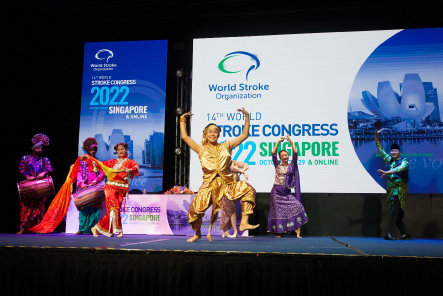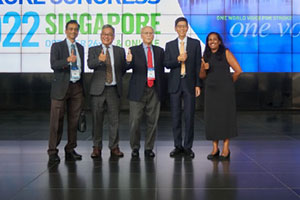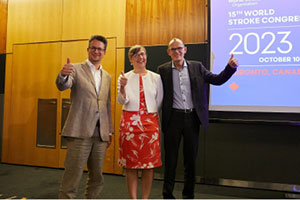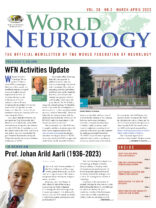By Stefan Kiechl and Deidre De Silva
 The World Stroke Congress (WSC) is the flagship meeting of the World Stroke Organization (WSO). After the exclusively virtual events in 2021 and in 2020 (joint conference with the European Stroke Organization), the WSC 2022 in Singapore was the first international large-scale in-person meeting. With more than 4,400 attendees (approximately half in person and half online) this was the largest WSC ever. It served as an excellent opportunity to discuss latest clinical and research results with colleagues from all over the world. The participants were from 106 countries with highest attendance from colleagues from Australia, China, India, Indonesia, Malaysia, Philippines, Singapore, United Kingdom and the United States. The faculty of 204 invited speakers were well balanced across continents (Asia 34%, South and North America 24%, Europe 25%, Australia and Africa 18 %).
The World Stroke Congress (WSC) is the flagship meeting of the World Stroke Organization (WSO). After the exclusively virtual events in 2021 and in 2020 (joint conference with the European Stroke Organization), the WSC 2022 in Singapore was the first international large-scale in-person meeting. With more than 4,400 attendees (approximately half in person and half online) this was the largest WSC ever. It served as an excellent opportunity to discuss latest clinical and research results with colleagues from all over the world. The participants were from 106 countries with highest attendance from colleagues from Australia, China, India, Indonesia, Malaysia, Philippines, Singapore, United Kingdom and the United States. The faculty of 204 invited speakers were well balanced across continents (Asia 34%, South and North America 24%, Europe 25%, Australia and Africa 18 %).
The opening ceremony included a video message from Tedros Adhanom Ghebreyesus, WHO director-general. In the three-and-a-half day program Oct. 26-29, the scientific program committee organized 97 sessions, teaching courses, joint symposia, and plenaries. These covered a broad range of topics, emphasizing the latest research and breakthrough discoveries across the globe, with priorities in acute stroke therapy, primary and secondary prevention, rehabilitation and recovery, cardiac aspects, and intracerebral haemorrhage.
One priority of WSC was the cross-link with partner organizations. The WSO and World Federation of Neurology (WFN) organized a joint symposium on education in stroke. With the conference being held in Asia, this granted the opportunity to collaborate with stroke societies from Asia, such as the Chinese Stroke Association, Asia  Pacific Stroke Organization, Association of Southeast Asian Nations Neurological Association, and WHO South-East Asia Regional Office. Stroke support organizations substantially contributed to the WSC 2022, integrated into the main program and also in parallel independent sessions. During the coffee breaks, there was dialogues on non-communicable diseases (NCD).
Pacific Stroke Organization, Association of Southeast Asian Nations Neurological Association, and WHO South-East Asia Regional Office. Stroke support organizations substantially contributed to the WSC 2022, integrated into the main program and also in parallel independent sessions. During the coffee breaks, there was dialogues on non-communicable diseases (NCD).
The WSC 2022 had more than 20 late-breaking trials that were published in top journals like The New England Journal of Medicine and JAMA. One highlight was the first presentation of results of MR CLEAN-LATE. Patients admitted between 6 and 24 hours after stroke (NIH Stroke Scale ≥ 2, occlusion of the internal carotid artery or M1/2 segments of the middle cerebral artery), had a substantial benefit of endovascular stroke therapy. The only patients not considered in these trials were patients with large demarcated infarction (more than third of the territory of the middle cerebral artery) and patients with a collateral score of zero.  Patients with indications of endovascular stroke therapy according to DAWN or DEFUSE-3 criteria were also not considered. Other highlights were the meta-analysis of six trials comparing endovascular stroke therapy alone against bridging (combined with intravenous thrombolysis). In this meta-analysis including 2314 patients, endovascular stroke therapy could not prove to be non-inferior to bridging therapy and this is also valid for multiple subgroups. The first phase 3 trial on stem cells in stroke recovery (TREASURE) was negative, a lowering of systolic blood pressure under 120 in successful endovascular stroke therapy has negative impact on the patients’ outcome (ENCHANTED2), and treatment by tenecteplase was non-inferior to alteplase treatment (AcT Study).
Patients with indications of endovascular stroke therapy according to DAWN or DEFUSE-3 criteria were also not considered. Other highlights were the meta-analysis of six trials comparing endovascular stroke therapy alone against bridging (combined with intravenous thrombolysis). In this meta-analysis including 2314 patients, endovascular stroke therapy could not prove to be non-inferior to bridging therapy and this is also valid for multiple subgroups. The first phase 3 trial on stem cells in stroke recovery (TREASURE) was negative, a lowering of systolic blood pressure under 120 in successful endovascular stroke therapy has negative impact on the patients’ outcome (ENCHANTED2), and treatment by tenecteplase was non-inferior to alteplase treatment (AcT Study).
The WSC 2022 in Singapore contributed to a better clinical stroke management in the future and facilitated discussion about stroke care in various geographical regions. Hundreds of delegates, local organizers, and stroke advocates joined the annual Walkathon and with “One Voice” raised stroke awareness. The WSC 2023 will be organized in Toronto (Canada) between Oct. 10-12, a few days before the congress of the WFN in Montreal from Oct. 15-18. •
Stefan Kiechl and Deidre De Silva Chaired the Scientific Committee of WSC 2022.
